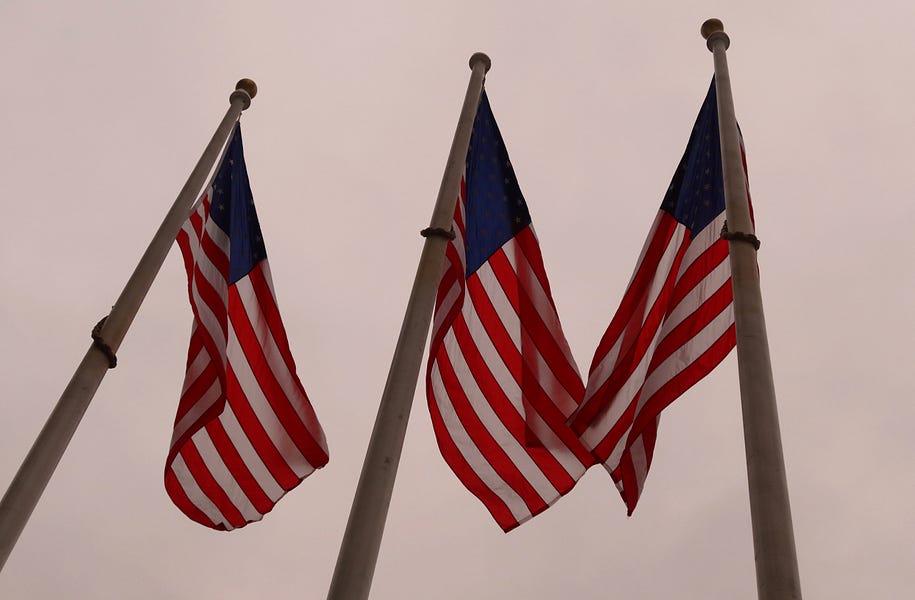What is America? What was America? Most importantly of all—what should America become?
These are questions that have haunted the United States since its founding, becoming especially acute in times when what had felt like a consensus on the answers breaks down and the search for new ones begins.
It would appear that we live in such times now. Between the phenomenon of Trumpism on the right and the cultural crusades of the left, with the Cold War long over and the War on Terror presently on the backburner, American thinkers on right and left are desperately searching for unifying causes and principles, a way to reforge and heal a deeply divided America.
One of the solutions proposed, especially by thinkers such as Yoram Hazony and Rich Lowry, is nationalism. The idea is that the elements of at least a form of national identity—one based in religion, ideas, place, and so on—have always been present in the American national DNA, and that these need only be adapted to current circumstances.
It’s a tempting and understandable concept; one need not support Donald Trump at all to realize that the promise of making America “great again” is something that easily resonates with many Americans who believe that the United States was once united in purpose and culture until something (usually someone) ruined it—and that we need only will it back into existence based on this or that formula.
George Washington University professor Samuel Goldman is a great deal more skeptical. In his new book After Nationalism, he warns those amenable to the idea to look at the actual efforts that have been made to unify the people of the United States into a uniform whole, efforts which left lasting legacies—but also lasting scars. Less a comprehensive survey of American identity than a commentary on its general ebb and flow, this work is required reading for anyone interested in starting to answer the questions above.
Goldman divides these efforts historically into what he calls the Covenant, the Crucible, and the Creed. If you wish, these were three versions of a City on a Hill—Jerusalem, Rome, and London.
Covenant
Let us start with the effort to create an American Jerusalem. When the country was first founded, it was as close to ethnic and cultural homogeneity as it gets, with about 90 percent of the country’s citizenry (excluding the slave population) being from the British Isles, religiously Protestant, and racially Caucasian. This was especially apparent in New England, where much of the country’s commercial and religious elite resided for a great deal of its existence.
They told a story of America from an almost Burkean perspective, a nation born of England, tied together through a covenant based on a Protestant understanding of the Bible, with the virtues inherited from the mother country. The basis for the future Whig Party, this was a vision of an America that was economically diverse and culturally uniform, suspicious of if not hostile to foreign immigrants, and against territorial expansion that might dilute or undermine the nation’s stable, solid character.
It was this desire to maintain the nation’s unity that drove things like the effort to build public schools and to pass moral laws like temperance. But it was also a desire doomed to failure. America was always more than just New England, and David Hackett Fischer identifies at least four different “groups” of Englishmen in the new United States, few of which agreed with the New England vision.
They wished for a Jerusalem, a uniting city from which religion and tradition would pour forth and bind its members to the past just as tightly as the present. But too much of the country and its energy was heading in another direction—chaotic, unrestrained, uncertain.
It was then that a new conception of the nation came to be, one which Goldman calls the crucible.
Crucible
America in the 1840s and through the Civil War was a country on the move. Between conquering the frontier, absorbing millions upon millions of immigrants, and transitioning from a farm-based economy to an industrial one, it largely broke free of the pastoral, stable, and sometimes backward-looking nationhood envisioned by the New England set.
Instead of holding fast to a uniform and nearly static vision of America, American cultural elites and political leaders now spoke of a melting pot or crucible, a forge in which a truly new nation would be forged from the innumerable people arriving on its shores. The cities and factories, towns and farms would lead to mixing and matching, creating a people still bound together by at least a generic form of worship but more importantly a sense of mission and direction. This was an identity that was future-oriented, more a nation in progress than a finished project.
Of course, many of the old debates still held sway. Many old-guard Americans wanted to force newcomers into the vice of WASPhood or some other uniform American identity. As ethnic diversity increased, with freed slaves moving out of the south and more immigrants from Asia coming in, Europeans were more apt to find commonality in their skin color while rejecting others. And some, like Frederick Douglass, rejected the idea of a pure melting pot in favor of something more akin to a Great Symphony—still a new nation, but one in which different peoples played their own special roles instead of everyone becoming the same.
The new Rome, then, bringing so many peoples under its rule, achieved only mixed results in creating a new nation. Some assimilated, some were massacred (especially Native Americans), some were marginalized, and some maintained their old ways and only partially integrated. The totalizing vision did not come to pass.
Which brings us to the third vision for American national identity, the one which most Americans—on the right and the left—remember and engage with when debating America’s future. Not a Jerusalem as a national capital, or a Rome fusing and creating a civilization away from the barbaric hordes, but a London spreading the creed of civilization (as understood by Americans) to every corner of the globe.
I speak, of course, of America as a nation forged by and based on a creed.
Creed
The 20th century has rightly been called the American Century. It is in this period that the United States went from being a country generally averse to being involved in world affairs to dominating international politics and discourse. It fought and helped win two world wars, followed by fighting and winning a global battle for dominance with the communist ideology in the Cold War.
But to do this, it needed to fundamentally change. As Goldman notes, the idea of America as a nation based on grand, abstract philosophical ideas rather than a specific people(s) or connection to the land itself was something that took off in this period. Others had paid homage to the concept before, of course, but it was in this period when there was a steady, concentrated, government-driven effort to drive home the point, both domestically and abroad.
Both Democratic and Republican presidents embraced this notion, with FDR celebrating America as a nation of immigrants and Dwight Eisenhower endorsing a religiously ecumenical concept of the United States as a nation based on belief in some form of God and democracy and freedom. The army in particular served as a “school of the nation” in the same way public schools had once been designed to assimilate immigrants to become good Protestant Americans.
But underneath this idealistic surface were serious fissures. Aside from the jingoistic assaults on German and later Japanese Americans during the world wars, there was a wide gap between the claims of equality and freedom and the way many Americans were actually treated, both at the time and previously.
Black and Native Americans in particular had a lot to say about this pretense to harmony. Left and right increasingly formed battle lines during the 1960s over everything that America stood for, from family life to national policy to religion to even the Constitution itself. The post-WWII consensus, so greatly and fondly remembered by many, with ideals claimed to be the hope not only of America but the world itself, lasted for an even shorter time than the previous two visions. Fighting the Cold War still united Americans more or less, but little else did.
Facing a Broken Reed
Reading all this, it’s easy to understand Nathan Glazer’s famous statement (quoted in the book) that “We are all multiculturalists now” as less a statement of ideology than an admission of failure and resignation.
Put simply, all attempts to forge America into a unified whole have been defeated by America itself. The country and its people were, are, and probably always will be simply too diverse, too deeply divided on matters of genuine principle, too at odds as to where they come from and where they wish to go to become a stolid but stable nation-state by any definition one chooses.
Goldman finishes After Nationalism by making a plea for more humility and more restraint. Instead of charging forward with yet another grand unifying project to reforge a divided nation, he argues we should strive to arrive at looser accommodations, in which the United States is more a “community of communities” where people look to their own, seeking to influence rather than dominate, where middling institutions are rebuilt or strengthened to calm the passions. If you will, a social philosophy federalism and not just a governmental one.
Problems and Promise
As I said: This is more an extended essay than a comprehensive study on the subject, and scholars and thinkers will no doubt object to this or that detail being left out or given too much emphasis. Of particular note is the lack of detailed attention to things like the sexual revolution, presently at the forefront of cultural debates in American life, or the documented collapse of social community discussed by people like Harvard political scientist Robert Putnam. I would add to Goldman’s demurral regarding the chances of unity that American unity was always and everywhere achieved with the aid of a “vis-à-vis,” a country or people or ideology with which to contrast itself.
New England and America generally could compare their freedom and prosperity to the “tyranny” of European monarchy and empire in the Covenant and Crucible periods, and to the totalitarian ideologies of the 20th century in the “Creed” period. But all those enemies have been more or less vanquished. Genuine concerns about China or terrorism or Putin aside, there really is no hegemonic competitor to the United States for the foreseeable future, either in terms of power or attraction. Even Europe has been mostly shaped in mimicry of the United States, with many openly hoping for the European Union to one day be a U.S. of the Old World.
But there are also real problems with Goldman’s plea for restraint, admirable and sensible though it may be.
For starters, Americans don’t do humble. Or restrained. As he himself described, Americans have been trying to impose uniform visions of the country just as much as other Americans resented and resisted the same for pretty much the entirety of America’s history. One might even say that the two parties have often taken turns being the “impose this morality” and “leave me alone” parties depending on the issue.
Wokery is just the latest example in a long line of such efforts. Indeed, the same apostles of unity that once served Protestant domination and later creedal nationalism—public school teachers, government officials and statisticians, big business owners, university professors—are hard at work trying to spread and enforce the new national gospel both at home and abroad. The only thing that’s changed is the faith they are spreading.
Some might take a detached, Olympian view of it all, knowing that this effort will fail just as all the others ultimately did and letting it destroy itself of its own accord. But as the book itself notes, a lot of damage can and perhaps will be done before that happens, including the crushing of whole cultures and communities. Ordinary Americans can’t afford to be so aloof.
In addition, it’s hard for me to see where these pillars of a new American arrangement are supposed to come from. As Putnam and others thoroughly documented, the old mediating institutions are desiccated or dead. To the extent they still exist, they are primarily the lot of the upper middle class making all the trouble. Family life and religion are also seriously in trouble.
And proceduralism and the Constitution? Even setting aside Barone’s Law, per which all process arguments are insincere, I see precious little evidence today that there is even homage being paid among America’s political leaders to the rules and norms of the Constitution or even democratic governance. It’s power uber alles (in the name of the righteous cause, of course) all the way.
On the other side of the ledger, I would not be so quick to dismiss the previous conceptions of American identity. They may have been only partial and they failed to completely unify, but they remain parts of American discourse today. Even the woke speak of a nation “yet to be born” in the same vein those supporting the Crucible vision, while many on the right still adhere to important parts of the Covenantal or Creedal one. Americans are divided, but they deeply care about unity, after a fashion, and these former attempts at unity and national identity are less dead than weakened.
It is true that perfect, all-encompassing unity is a chimera. Even the woke constantly run into contradictions and struggles in their constant effort to create a “socially diverse but ideologically uniform” nation. But even if the country and its people’s boundaries are loose, they still need to be there, even without a “vis-à-vis.” Even a “community of communities” needs things it shares in common, even if nowhere near as coherent as the vision of the Covenant. And these need to be things for which they are willing to fight and maybe even die in extremis.
In this sense, the right’s efforts to poke fun at the left’s uniform diversity are fair but also self-defeating. There is far more diversity in America than the left’s corporate PR imagery suggests, and this diversity should be acknowledged and even protected. But it’s also true that the drive for pure individualism and near atomism has created some of the mess we now have to clean up, and if the old 1950s vision is not to their liking, something else needs to come in its place.
What will that be? Will it be some mix of the old visions of Jerusalem, Rome, and London? Will it be something new? I don’t know the road ahead, but we all owe a debt of gratitude to Goldman for charting the path we have taken thus far, providing us with important lessons as we once again try and find a way to both understand America and its place in the world.






Please note that we at The Dispatch hold ourselves, our work, and our commenters to a higher standard than other places on the internet. We welcome comments that foster genuine debate or discussion—including comments critical of us or our work—but responses that include ad hominem attacks on fellow Dispatch members or are intended to stoke fear and anger may be moderated.
With your membership, you only have the ability to comment on The Morning Dispatch articles. Consider upgrading to join the conversation everywhere.